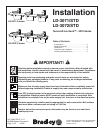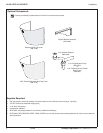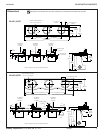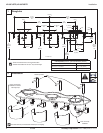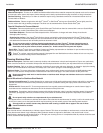
Installation LD-3071/STD, LD-3072/STD
Bradley Corporation • 215-1640; EN 07-1111 4/1/08 5
Cleaning and Maintenance for Terreon
®
Material Description: Terreon
®
is an NAHB Certifi ed densifi ed solid surface material composed of polyester resin and is resistant
to chemicals, stains, burns and impact. Surface damage can be easily repaired with everyday cleansers or fi ne grit abrasives.
Routine Cleaning: Clean daily or as often as conditions require using a standard commercial or household cleaner such as
Formula 409
®
or Windex
®
.
Stubborn Stains: Remove tough stains with Ajax
®
, Comet
®
, or Soft-Scrub
®
and a green Scotch-Brite
®
pad or lightly sand in a
circular motion with 240 grit wet/dry sandpaper. The fi nish can be renewed with a maroon Scotch-Brite
®
pad.
Special Situations for Terreon Material
Scratches: Remove scratches with a green Scotch-Brite
®
pad. The fi nish can then be renewed with a maroon Scotch-Brite
®
pad, followed by a white Scotch-Brite
®
pad or 30-micron sandpaper.
Hard Water Deposits: Remove hard water deposits with a mild solution of vinegar and water. Always rinse the unit
thoroughly after cleaning.
Restoring the surface: Use Hope’s
®
Solid Surface cleaner and polish to refresh and protect the Terreon
®
Solid Surface
material. Bradley recommends additional care and maintenance for the darker colored Terreon
®
, for complete instructions on
this additional maintenance refer to Bradley technical document #1505.
Do not use strong acid or alkaline chemicals and cleansers to clean Terreon
®
. If these chemicals come in
contact with the surface, wipe them off immediately and rinse with soapy water. Avoid contact with harsh
chemicals such as paint remover, bleach, acetone, etc. Avoid contact with hot pans and objects.
Repair Kits: Terreon
®
repair kits are available. Contact your Bradley representative or distributor for part numbers and pricing
Repair kits are made to order and have a shelf life of 30 days.
Terreon
®
is a unique, cast solid surface material. Aggregate fl ow and distribution as well as shades of color can vary from
product to product creating natural characteristics.
Cleaning Stainless Steel
Material Description: Stainless steel is extremely durable, and maintenance is simple and inexpensive. Proper care, particularly
under corrosive conditions, is essential. Always start with the simplest solution and work your way toward the more complicated.
Routine Cleaning: Daily or as often as needed use a solution of warm water and soap, detergent, or ammonia. Apply the cleaning
solution per the manufactures instructions and always use a soft cloth or sponge to avoid damaging the fi nish.
Stubborn Stains: To remove stains from stainless steel use a stainless steel cleaner and polish such as Ball® stainless steel
cleaner or a soft abrasive. Always follow the manufactures instructions and apply in the same direction as the polish lines.
Never use ordinary steel wool or steel brushes on stainless steel. Always use stainless steel wool or stainless
steel brushes.
Special Situations for Stainless Steel Material
Fingerprints and Smears: To remove fi ngerprints or smears use a high quality stainless steel cleaner and polish in accordance
with the manufactures instructions. Many of these products leave a protective coating the helps prevent future smears and
fi ngerprints.
Grease and Oil: Grease and Oil : To remove grease and oil use a quality commercial detergent or caustic cleaner. Apply in
accordance to the manufactures instructions and in the direction of the polish lines.
Precautions: Precautions: Avoid prolonged contact with chlorides (bleaches, salts), bromides (sanitizing agents), thiocyanates
(pesticides, photography chemicals, and some foods), and iodides on stainless steel equipment, especially if acid conditions
exist.
Do not permit salty solutions to evaporate and dry on stainless steel.
The appearance of rust streaks on stainless steel leads to the belief that the stainless steel is rusting. Look for the actual source
of the rust in some iron or steel particles which may be touching, but not actually a part of the stainless steel structure.
Strongly acidic or caustic cleaners may attack the steel causing a reddish fi lm to appear. The use of these
cleaners should be avoided.
Brand Names
Use of brand names is intended only to indicate a type of cleaner. This does not constitute an endorsement, nor does the omission
of any brand name cleaner imply inadequacy. Many products named are regional in distribution, and can be found in local
supermarkets, department and hardware stores, or through your cleaning service. It is emphasized that all products should be used
in strict accordance with package instructions.



